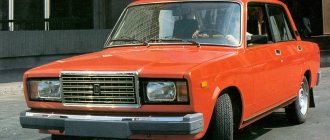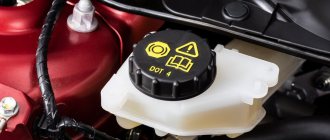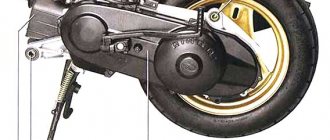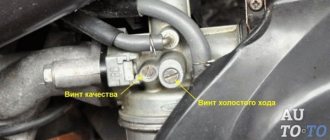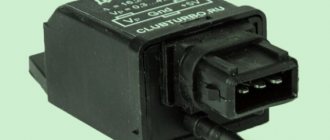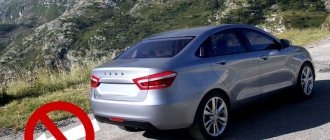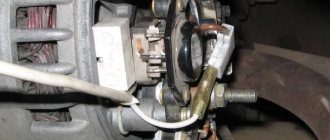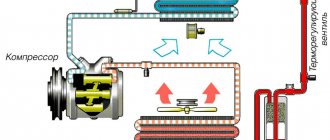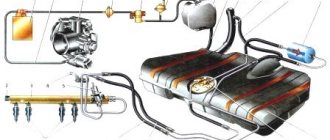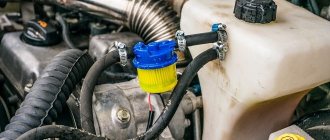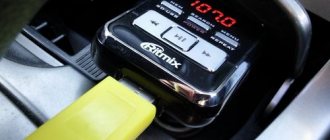Tuning of domestic cars usually ends with changes in the external appearance of the car or interior trim. You can especially often find tuning of a VAZ 2107 car. Tuning includes many different changes and additions, starting with the car's LED lighting and ending with an automatic engine start button.
You can replace all the factory light bulbs, install comfortable seats, install a new steering wheel, etc., but all this is done for the sake of comfort and standing out from the crowd. However, serious car enthusiasts must first think about the safety of their car.
Engine start button for VAZ 2107
Brake system VAZ 2107
It's no secret that the safety systems provided for the VAZ 2107 have not undergone significant improvements since the first production of the car. There are no airbags or related electronics in such a car. Once you get your hands on such a car, the first thing you need to do is check the brakes. In fact, a car's safety systems are based on the car's braking performance.
Crash test
As crash tests of domestic cars show, it makes no sense to rely on the car body itself. A frontal or side collision with an obstacle already at a speed of 64 km/h will turn the “seven” into an accordion.
Thus, there is no space left for the driver or passengers. Despite all the “unsafety”, the VAZ 2107 is very popular among car owners. Fortunately, it is now not difficult to find spare parts for tuning domestically produced cars and you can modernize your car without any problems.
The device of the "seven" brake mechanism
The system is designed for smooth or emergency stopping. As we have already determined, it is the main security system, and operation of the car is prohibited even if the slightest malfunction is detected.
In a classic braking system, the pedal is mounted on the same axis as the clutch pedal and is equipped with a return spring. This mechanism has a built-in sensor for turning on the rear brake light lamps.
Next comes the brake master cylinder. It is attached to the body in the engine compartment with two bolts and has working braking circuits for the front and rear wheels.
Now you can find vacuum boosters to reduce the effort applied to the pedal. The drive of such an amplifier is a fitting . It is mounted in the intake manifold, connected by a rubberized pipe. For reliability purposes, the front circuit has two fittings per wheel, and the rear circuit has one fitting.
Main brake cylinder VAZ 2107
Piston disc brakes are used on the front wheels. They are installed for greater braking efficiency, since a greater load is placed on the front wheels than on the rear ones.
Caliper VAZ 2107
The rear wheels are equipped with drum brakes. Structurally, they are much simpler than disk ones. As is known, their efficiency is extremely low, but is quite sufficient for rear-wheel drive vehicles. In addition, it is not profitable for the manufacturer to install more expensive disk mechanisms. A parking brake mechanism is also built into the rear wheel brakes.
Rear hub VAZ 2107
An important mechanism of the system is hidden under the bottom of the car in the rear - this is the pressure drop regulator in the system. This mechanism distributes the pressure that is created during braking between the front and rear circuits.
Differential pressure regulator
Basic faults
The brake system itself is quite simple, but some of its elements require special attention. Main types of faults:
- The brake fluid leaks, resulting in a drop in pressure in the system. If a preliminary inspection does not find a leak, it is necessary to check the brake master cylinder. We bend the noise-insulating mat located under the brake pedal and inspect for streaks in the area of the rubber seal of the master cylinder. The presence of drips will indicate that the cause has been found and requires disassembling the cylinder and then replacing the cuff. If there is a vacuum booster, the brake master cylinder must be removed and inspected.
- When you release the brake pedal, the car drives sluggishly. Reason: the rear or front pads are jammed. Seized pads are identified by checking the heat of the corresponding wheel. We touch each disk - the hottest one will be jammed. In the case when these are the front wheels, you can, after removing the wheel, move the brake cylinder. If this fails, you will have to replace it with a new one. In the case of rear pads, the brake wheel cylinder will need to be replaced.
- When you press the pedal, braking does not occur, but it does when you press it several times in a row. This may indicate the presence of air in the system. The solution to the problem is to bleed the brakes to remove air.
- Problem with the handbrake. Most often this problem occurs in winter. It manifests itself in the fact that after a long period of parking, when the handbrake is released, the wheels remain locked. The reason is that the parking brake cable is frozen. During its operation, moisture gets there and freezes in winter. If the casing is severely damaged, it will have to be replaced.
Brake master cylinder diagram
How does a car's braking system work?
First, a little theory. The braking system is necessary in any vehicle to change the speed of the vehicle, perform maneuvers based on the situation on the road, and stop.
Despite the abundance of brands that the modern automotive industry offers consumers, the principle of its operation is the same for everyone. It consists of:
- pedals;
- master brake cylinder;
- connecting fittings (pipes);
- working cylinders located on both axes of the machine;
- amplifier
The driver, pressing the pedal in the cabin, exerts pressure through the piston of the master cylinder on the brake fluid, which enters the system. It acts on the working cylinders, which operate the braking devices.
When the pedal is released, the reverse operation occurs: the “brake fluid,” as drivers call it, returns to the main cylinder and reservoir, and the wheels become free.
Braking mechanisms
They are divided into two types: drum type and disk type. The first type was invented by the famous Frenchman Louis Renault, founder of the Renault brand, in 1902. In the same year, William Lanchester from the shores of Britain patented a disk system. It was not popular due to the terrible squeaking noise that the copper pads made when in contact with the disc.
The disc version in its modern form appeared much later: in 1953, they were installed on the Jaguar by British Girling.
Drum brakes. They consist of the drum itself, a metal bowl attached to the hub, one or two cylinders, springs, and pads. When you press the pedal, the latter diverge, press against the rounded surface of the drum, which rotates with the wheel, and braking occurs.
The entire load from the friction of the two components of the system falls on the friction linings, which are glued or riveted to the metal body of the pads.
Such mechanisms are considered less efficient in the modern automotive industry, so now they are installed mainly on commercial vehicles, on the rear wheels of some brands of passenger cars.
Disc brakes
The system consists of a perfectly smooth cast iron disc located on the hub, a caliper containing two pads, and one or two working cylinders. The caliper itself is attached directly to the car's suspension.
When braking, the device is driven by hydraulics, which ensures close contact between the friction linings of the pads and the disc.
What is the advantage of a disk system?
Let us explain why manufacturers of modern cars prefer such devices:
- More stable braking. The area of the contact spot in the drum form is larger than in the disk form. However, the pistons are not able to press the pads evenly, which affects the quality of the process. The pads in the system with the disc press it on both sides, ensuring quick stop of the wheel.
- Disc brakes are smaller in size and weight. The operating temperature is much lower. The ventilation holes in the disk and the small size of the contact area between the parts are to blame for this. As a result, they overheat less, making braking more effective.
- Friction linings are located inside the drum device. All dust from friction falls on the contacted surface, which also interferes with the high-quality deceleration of the car.
- Disc brakes are convenient: they are easier to maintain.
Modern industry produces regular and ventilated disks. The latter provide airflow through the holes, which allows to reduce the operating temperature. They are wider than usual in thickness, cost more, but have a longer service life.
Having understood the principle of operation of the system, let’s move on to the main topic of the review.
Replacing brake discs yourself
Replacing front discs
Replacing brake discs is necessary when its thickness is less than 9.5-11 millimeters. When the pads wear out, the pistons can come out of their seats and create misalignment. The second reason for replacement may be uneven wear and deep risks .
Large output on the VAZ 2107 disk
Such problems increase brake pad wear and reduce braking performance. In these cases, the disks must be replaced. Their timely replacement is the key to your safety.
Remove the wheel and caliper with brake pads. To do this, unscrew the two guide pins.
Guide pins VAZ 2107
Next, remove the intermediate ring and the worn disc.
Removing the VAZ 2107 disk
After this, the new disk is installed in the reverse order.
Polishing a car - a complete guide. You will learn how to start tuning in our article!
Choosing acoustics is always a difficult task. Even more so for cars. The link has information that will help you!
Installation of disc brakes on the rear axle of a VAZ 2107
As you know, the rear axle of the VAZ 2107 was initially equipped with drum brakes rather than disc brakes, which are not very efficient. In this regard, many car enthusiasts independently replace these brakes with disc brakes. Let's look at this procedure in more detail.
Sequencing
To work, we will need the tools listed in the list above. In addition to them, we will need a rust cleaning liquid. It's better if it's WD40.
- The car is jacked up and the rear wheels are removed. Provides access to the brake drums and rear axle shafts. The axle shafts are thoroughly wiped off from dirt using a rag, and if necessary, treated with WD40.
- The brake fluid from the system is drained into a previously prepared container. The pads are removed from the brake drum, then it is removed along with the axle shafts so that only the brake pipes remain.
- The mounting rings and wheel bearings located under the rings are removed from the axle shafts.
- Now the axle shafts are ground on a lathe so that their diameter matches the diameter of the selected brake disc (at this stage of the work, the car owner will need the help of a qualified turner). After this, holes are drilled in the axle shafts for the brake disc mounting bolts.
- The axle shafts improved in this way are installed back on the rear axle of the VAZ 2107. A brake disc is installed on top of them and screwed with a pair of mounting bolts as shown in the photographs above. After securing the discs, disc calipers with pads are installed on them, the rear wheels are installed in their regular places and the car is lowered from the jacks.
Video: setting rear disc brakes to “classic”
So, even a novice car enthusiast can change the front brake discs on a VAZ 2107. All that is required is the ability to use wrenches and a minimal understanding of how a disc brake system works. As for replacing rear drum brakes with disc brakes, it will not be possible to do this without the help of a qualified turner.

